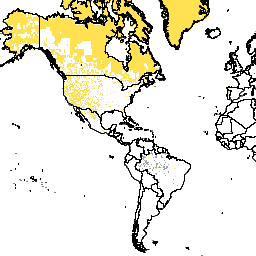
- توفّر مجموعة البيانات
- 2000-01-01T00:00:00Z–2020-01-01T00:00:00Z
- مزوّد مجموعة البيانات
- مركز NASA SEDAC في "شبكة معلومات علوم الأرض الدولية"
- العلامات
الوصف
تحدّد مجموعة البيانات هذه وحدات البكسل المائية، ويتم إخفاء وحدات البكسل غير المائية. تم استخدام قناع المياه لاستبعاد مناطق المياه والجليد الدائم من عملية تخصيص السكان.
يقدّم الإصدار 11 من "تعداد السكان في العالم" (GPWv4) توزيعًا للسكان في العالم خلال الأعوام 2000 و2005 و2010 و2015 و2020 في خلايا شبكية تبلغ مساحتها 30 ثانية قوسية (كيلومتر واحد تقريبًا). يتم توزيع السكان على الخلايا باستخدام التوزيع النسبي للسكان من التعداد السكاني والوحدات الإدارية. يتم جمع بيانات السكان المدخلة بأعلى دقة مكانية متاحة من نتائج جولة التعدادات لعام 2010 التي أُجريت بين عامَي 2005 و2014. يتم استقراء بيانات الإدخال لإنتاج تقديرات عدد السكان لكل سنة تم وضع نموذج لها.
النطاقات
حجم البكسل
927.67 متر
النطاقات
| الاسم | الحد الأدنى | الحد الأقصى | حجم البكسل | الوصف | |||||||||||||||||||||||||||||||||||||||||||||||||||||||||||||||||||||||||||||||||||||||||||||||
|---|---|---|---|---|---|---|---|---|---|---|---|---|---|---|---|---|---|---|---|---|---|---|---|---|---|---|---|---|---|---|---|---|---|---|---|---|---|---|---|---|---|---|---|---|---|---|---|---|---|---|---|---|---|---|---|---|---|---|---|---|---|---|---|---|---|---|---|---|---|---|---|---|---|---|---|---|---|---|---|---|---|---|---|---|---|---|---|---|---|---|---|---|---|---|---|---|---|---|---|
water_mask |
أمتار | قناع مائي |
|||||||||||||||||||||||||||||||||||||||||||||||||||||||||||||||||||||||||||||||||||||||||||||||||
بنود الاستخدام
بنود الاستخدام
الاقتباسات
مركز شبكة معلومات علوم الأرض الدولية (CIESIN) في "جامعة كولومبيا" 2018 Gridded Population of the World, Version 4 (GPWv4): Water Mask, Revision 11. Palisades, NY: NASA Socioeconomic Data and Applications Center (SEDAC). https://doi.org/10.7927/H42Z13KG. تم الوصول إليه في DAY MONTH YEAR.
معرّفات العناصر الرقمية
الاستكشاف باستخدام Earth Engine
أداة تعديل الرموز (JavaScript)
var dataset = ee.ImageCollection('CIESIN/GPWv411/GPW_Water_Mask'); var raster = dataset.select('water_mask'); var raster_vis = { 'min': 0.0, 'palette': [ '005ce6', '00ffc5', 'bed2ff', 'aed0f1' ], 'max': 3.0 }; Map.setCenter(-88.6, 26.4, 1); Map.addLayer(raster, raster_vis, 'water_mask');
